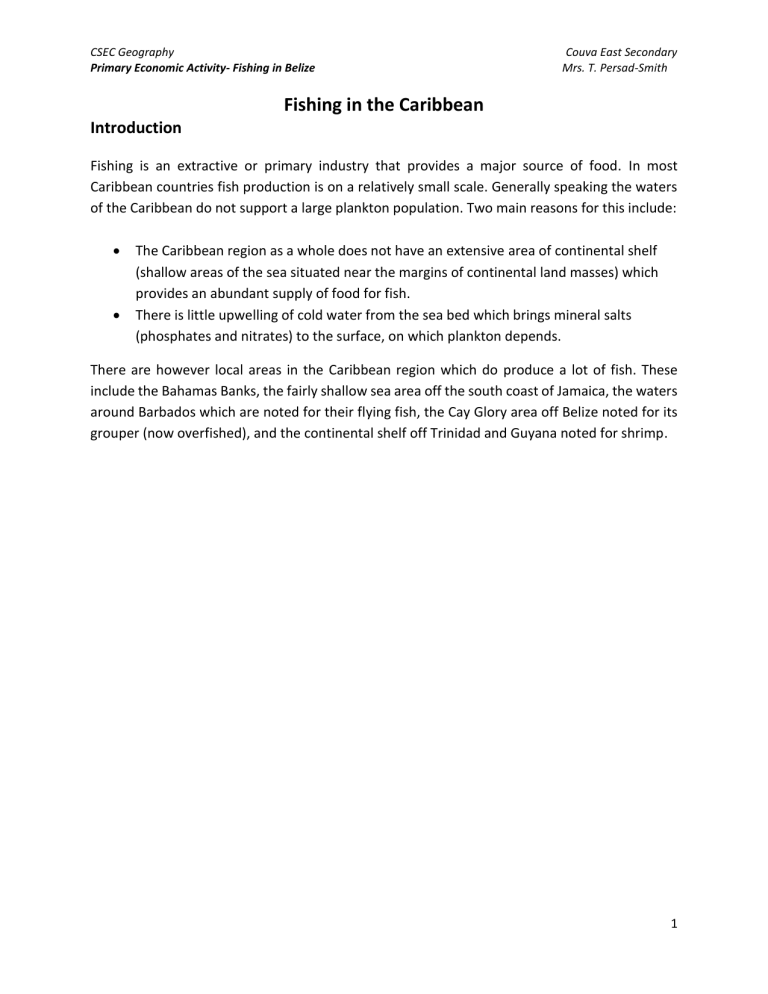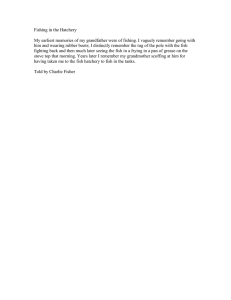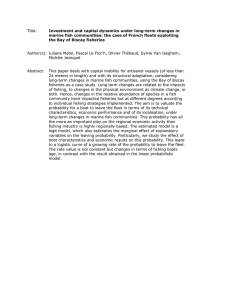
CSEC Geography Primary Economic Activity- Fishing in Belize Couva East Secondary Mrs. T. Persad-Smith Fishing in the Caribbean Introduction Fishing is an extractive or primary industry that provides a major source of food. In most Caribbean countries fish production is on a relatively small scale. Generally speaking the waters of the Caribbean do not support a large plankton population. Two main reasons for this include: The Caribbean region as a whole does not have an extensive area of continental shelf (shallow areas of the sea situated near the margins of continental land masses) which provides an abundant supply of food for fish. There is little upwelling of cold water from the sea bed which brings mineral salts (phosphates and nitrates) to the surface, on which plankton depends. There are however local areas in the Caribbean region which do produce a lot of fish. These include the Bahamas Banks, the fairly shallow sea area off the south coast of Jamaica, the waters around Barbados which are noted for their flying fish, the Cay Glory area off Belize noted for its grouper (now overfished), and the continental shelf off Trinidad and Guyana noted for shrimp. 1 CSEC Geography Primary Economic Activity- Fishing in Belize Couva East Secondary Mrs. T. Persad-Smith Case Study - Fishing in Belize Fisheries make up 6% of GDP but 29% of exports from Belize. The most valuable marine catch is shellfish, caught mainly by trapping and diving. Conch are next; some scale fish are also caught mainly in deeper waters. Factors influencing location Physical Raw material: Fish are abundant along the coast of Belize because of the extensive reef (2 nd largest barrier reef in the world- over 280km long) and in the three outer coral atolls of Turneffe Island, Glover’s Reef and Lighthouse Reef (See Map 1). There are breeding grounds in mangrove swamps and in seagrass meadows along the coast. Products include fish, lobster, shrimp, and conch. Map 1: Map of Belize showing main fishing locations Human Labour supply: Most fishermen live along the coastline, making it easy for them to carry out fishing as an economic activity. There are over 2000 fishermen and many shore-based jobs in processing and administration. Economic Market: Fish is sold along the coastline. Some of the buyers are wholesalers who retail the products to supermarkets and hotels. Others have special arrangements for shellfish to be exported. Earnings alone for shellfish are now more than US$12 million per year. 2 CSEC Geography Primary Economic Activity- Fishing in Belize Couva East Secondary Mrs. T. Persad-Smith Trends Fishing co-operatives- most fishermen belong to one of the five fishing co-operatives. A well run co-operative has many advantages o A big co-operative negotiates an export price for conch or lobster with a large overseas company. This is usually a higher price than if individual fishermen negotiate. o The co-operative buys the fishermen’s catch, process it and organises sales o At year’s end the profits are distributed to the members as a ‘second payment’ o The co-operative can make loans for the purchase of items such as outboard motors, trawlers. o Some co-operatives have funds to pay for education, pensions and sick pay. The industry is now linked to tourism- protection of fish and ecotourism (reef tours), as tourism depends on a healthy marine environment. The development of ‘catch and release’ fishing has species such as bonefish being thrown back into the sea when caught and are not killed or eaten. Conservation and sustainability o There is a closed season for conch from July – September and lobster from February to June when most breeding takes place o Young lobster and conch below a minimum size are not used. This gives them a chance to mature o Scuba diving for conch and lobster is not allowed. This prevents diving in water over 15m deep o Each co-operative has an annual quota, which cannot be exceeded. o Fishing for grouper is prohibited in most places because over fishing has damaged stocks. Aquaculture – fish farming under controlled conditions in tanks and ponds. In Belize, there are fourteen shrimp farms and one producing tilapia. It costs as least US$350,000 to set up a shrimp farm. Together they cover 28 sq km and employ 1400 staff. Nationally there are four processing plants, which produce 86 tonnes of shrimp a day. Most Belize aquaculture exports are sold to the USA. Since 2005, some Belize producers have been licensed for exports to the EU, with potential for extra profits. 3 CSEC Geography Primary Economic Activity- Fishing in Belize Couva East Secondary Mrs. T. Persad-Smith Challenges There have been some problems with the Belize fishing industry Sometimes fishermen sell their catch illegally across the border in Honduras or Mexico where they may get a slightly higher price There are no successful co-operatives to the south of the country. Fishing grounds are good here but most of the fish are caught by small farmers for their own use. Part time fishermen do not feel the need to increase their cash income by taking a larger catch for sale Foreign fishermen sometimes poach in some areas offshore sometimes even in the closed season Shrimp trawlers remove many young fish Pollution from land based activities, such as sewage and sedimentation from soil erosion threaten coral reefs and marine animals which live there. In March 2014 EU banned fish imports from Belize due to the occurrence of ‘nonsustainable’ fishing practices. Bibliography Ottley J. and Gentles, M. Geography for CSEC, England: Pearson Education Limited, 2006. Rahil, Vohn Complete Geography Course for CSec, Trinidad: Caribbean Educational Publishers, 2010. Wilson M. The Caribbean Environment for CXC Geography, England: Oxford University Press, 1998 4


